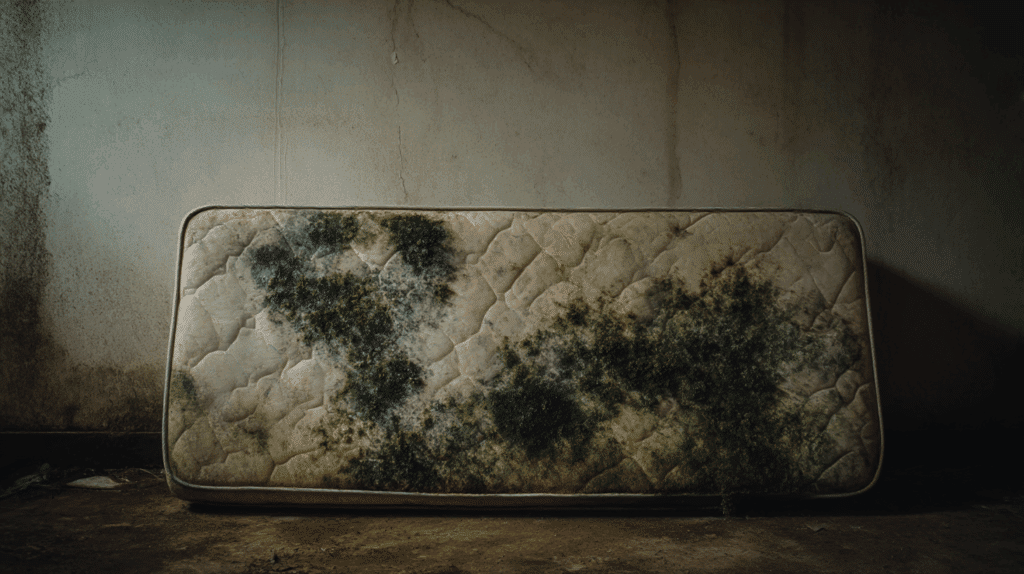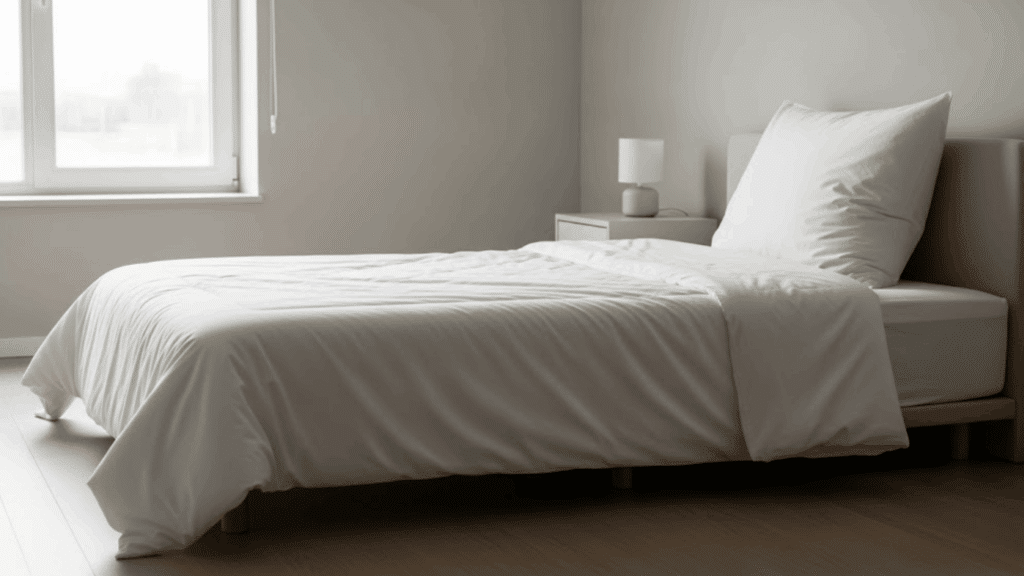That musty smell coming from your bedroom isn’t just “old house charm,” it could be mold making itself at home in your mattress.
Nobody wants to think about what’s lurking inside the place where they spend eight hours every night. Yet mattress mold is more common than most people realize.
It thrives in dark, warm, and humid conditions. Spilled drinks, night sweats, and everyday moisture can seep deep into mattress layers. Once mold takes hold, it doesn’t just stay put.
The health risks are real. From allergies to respiratory problems, mold exposure affects your well-being in profound ways.
Don’t panic, though. Understanding how mold grows and what to do about it puts you back in control of your sleep space.
Spotting Mold on Your Bed
Mattress mold represents a serious health and hygiene issue that affects countless households worldwide.
The combination of body heat, moisture from breathing and sweating, and limited air circulation creates ideal conditions for mold growth that many people never consider until problems develop.
How to Tell If There’s Mold on Your Mattress
Look for black, green, or white fuzzy patches on the surface or along seams where moisture tends to collect. A persistent musty or sour smell that doesn’t go away with regular cleaning is another red flag.
Pay attention to your body’s signals, including increased sneezing, coughing, itchy eyes, or worsening allergies after sleeping, which could indicate mold exposure.
Other telltale clues include unexplained dampness, yellow or brown discoloration, or feeling stuffy every morning despite good ventilation in your room.
The Difference Between Mold and Mildew
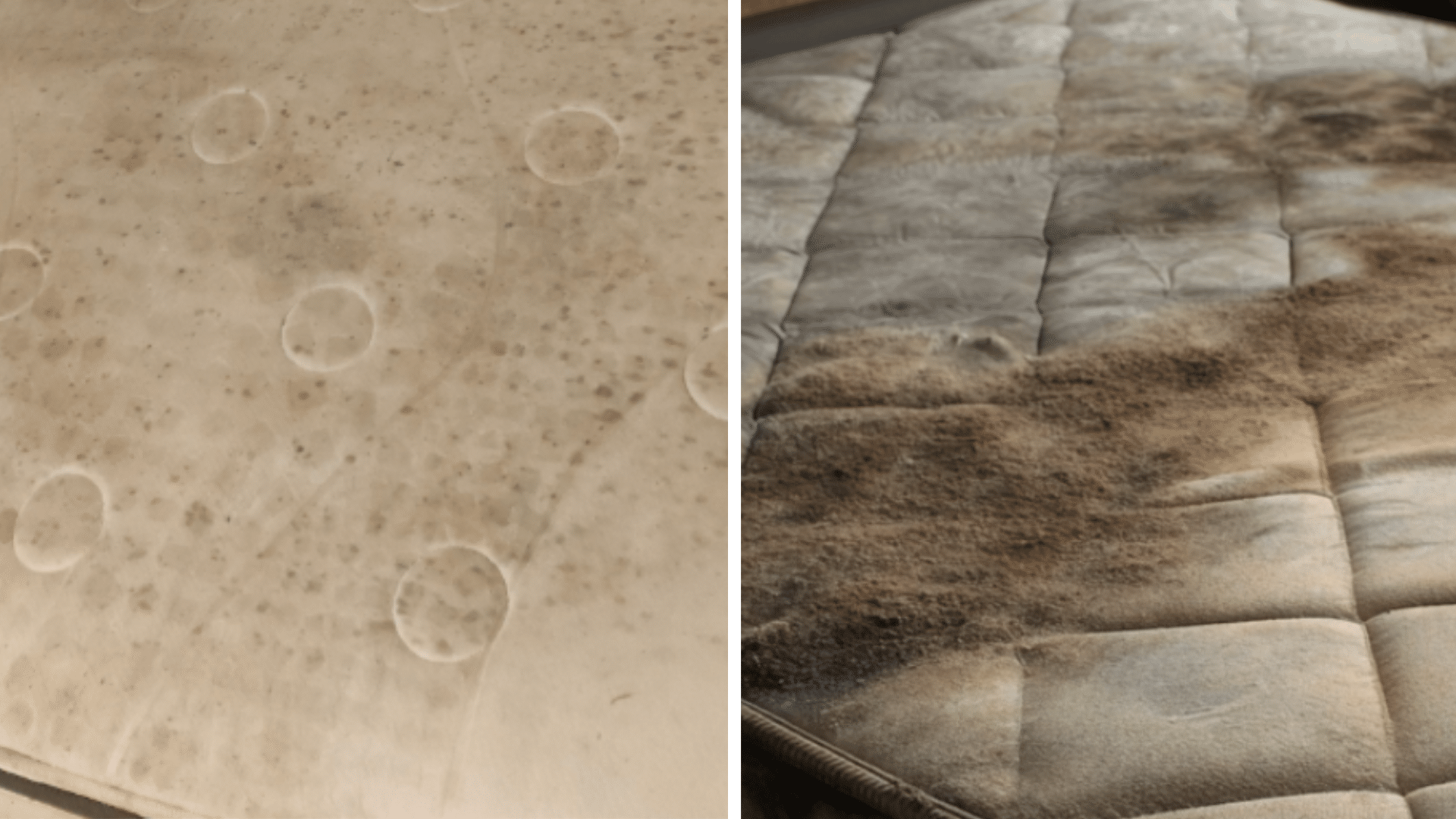
Many people use the terms mold and mildew interchangeably, but they’re different types of fungi with distinct characteristics.
| Feature | Mold | Mildew |
|---|---|---|
| Appearance | Fuzzy or slimy; green, black, or blue | Powdery or fluffy, white or gray |
| Growth Depth | Penetrates surfaces deeply | Stays on the surface |
| Odor | Strong, musty, earthy smell | Light, musty smell |
| Health Risks | Can trigger allergies, asthma, and respiratory issues | Usually causes mild irritation or sneezing |
| Cleaning Difficulty | Harder to remove; may need deep cleaning | Easier to wipe off with surface cleaners |
Regardless of whether you are dealing with mold or mildew, prompt action is essential for your health and mattress longevity.
Both fungi thrive in similar conditions, so the prevention strategies remain largely the same.
Health Risks of Mold on Mattresses
Sleeping on a mold-contaminated mattress exposes you to harmful spores and toxins for 6-8 hours every night, creating serious health consequences over time.
The prolonged exposure during sleep makes mattress mold particularly dangerous since you breathe these contaminants directly while your immune system is at rest.
Short-Term Health Effects
Immediate symptoms typically appear within hours or days of sleeping on a mold-contaminated mattress.
Common short-term effects include persistent sneezing, a runny nose, and itchy, watery eyes that resemble seasonal allergies.
Skin reactions like rashes, hives, or eczema flare-ups often develop where the body makes direct contact with moldy bedding materials.
Long-Term Health Effects
Continued exposure to mattress mold over weeks or months can lead to more serious health complications that require medical intervention.
Chronic respiratory problems, including persistent asthma, recurring bronchitis, and reduced lung function, may develop in previously healthy individuals.
The constant strain on the immune system from fighting mold toxins can result in chronic fatigue syndrome, frequent infections, and slower recovery times from common illnesses.
Some individuals may develop hypersensitivity pneumonitis, a serious lung condition that causes inflammation and scarring of lung tissue requiring ongoing medical treatment.
What Causes Mold to Grow on a Mattress?
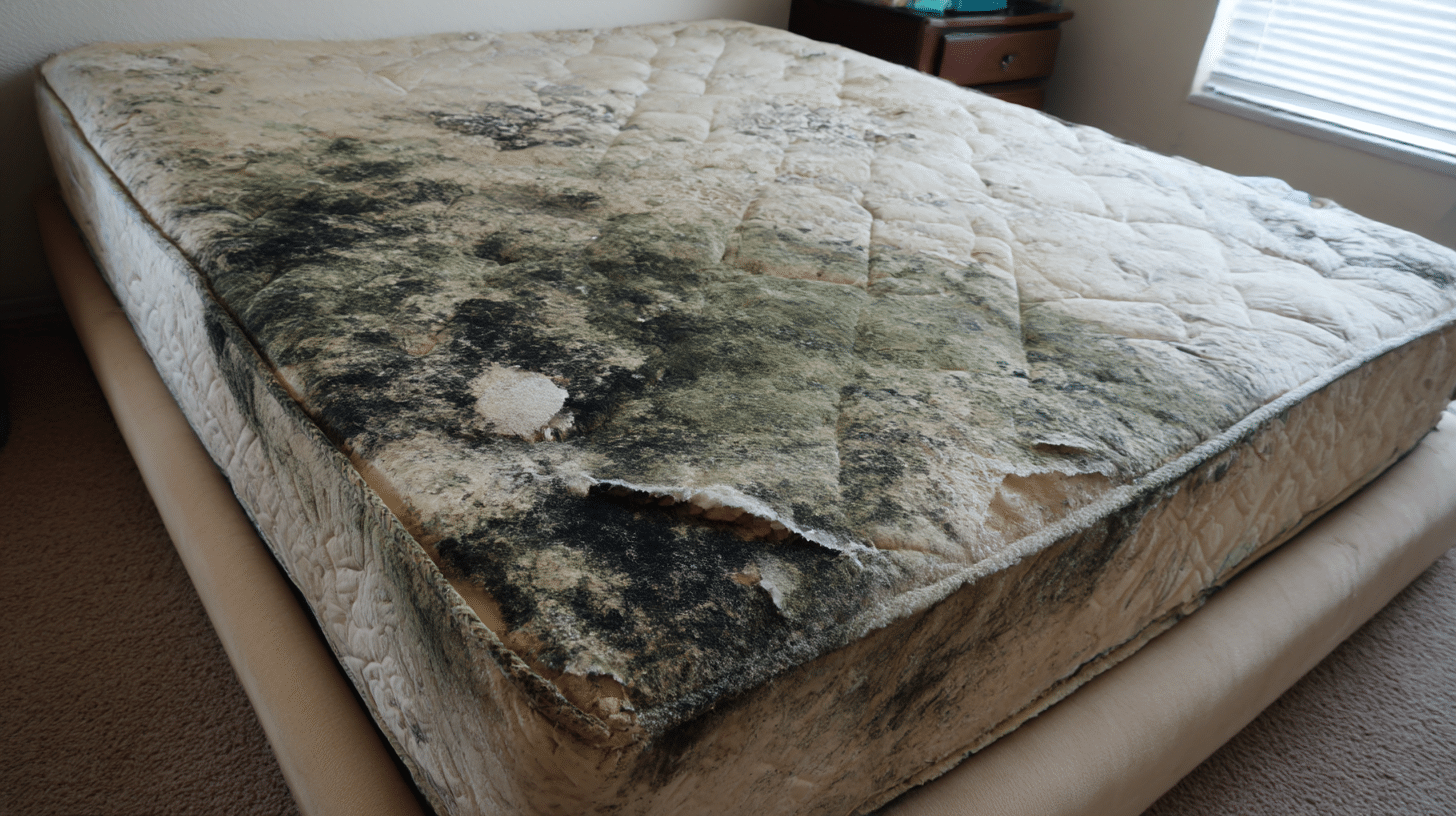
Mold doesn’t appear out of nowhere; it needs specific conditions to thrive and multiply in your mattress.
Understanding these conditions helps you prevent problems before they start and protect your sleep space from contamination.
- High humidity levels: Indoor humidity above 60% allows mattresses to absorb moisture from the surrounding air, creating ideal conditions for spore germination and growth.
- Poor bedroom ventilation: Stagnant air prevents moisture evaporation, causing dampness to persist in mattress layers where mold can establish colonies undisturbed.
- Untreated spills and sweat: Liquid that penetrates mattress materials within 24-48 hours creates wet pockets where mold flourishes if not properly cleaned and dried.
- Limited sunlight exposure: Dark spaces under beds trap moisture while preventing UV exposure that naturally kills mold spores and promotes drying.
- Blocked airflow: Storage boxes, bed skirts, or low frames restrict air circulation around the mattress, creating stagnant environments perfect for fungal development.
Several environmental factors work together to create the perfect breeding ground for mold growth.
Moisture is the primary catalyst that enables spores to establish colonies and spread throughout mattress materials. Changing these factors is the first step to removing mold from mattresses.
Methods to Clean Mold from a Mattress
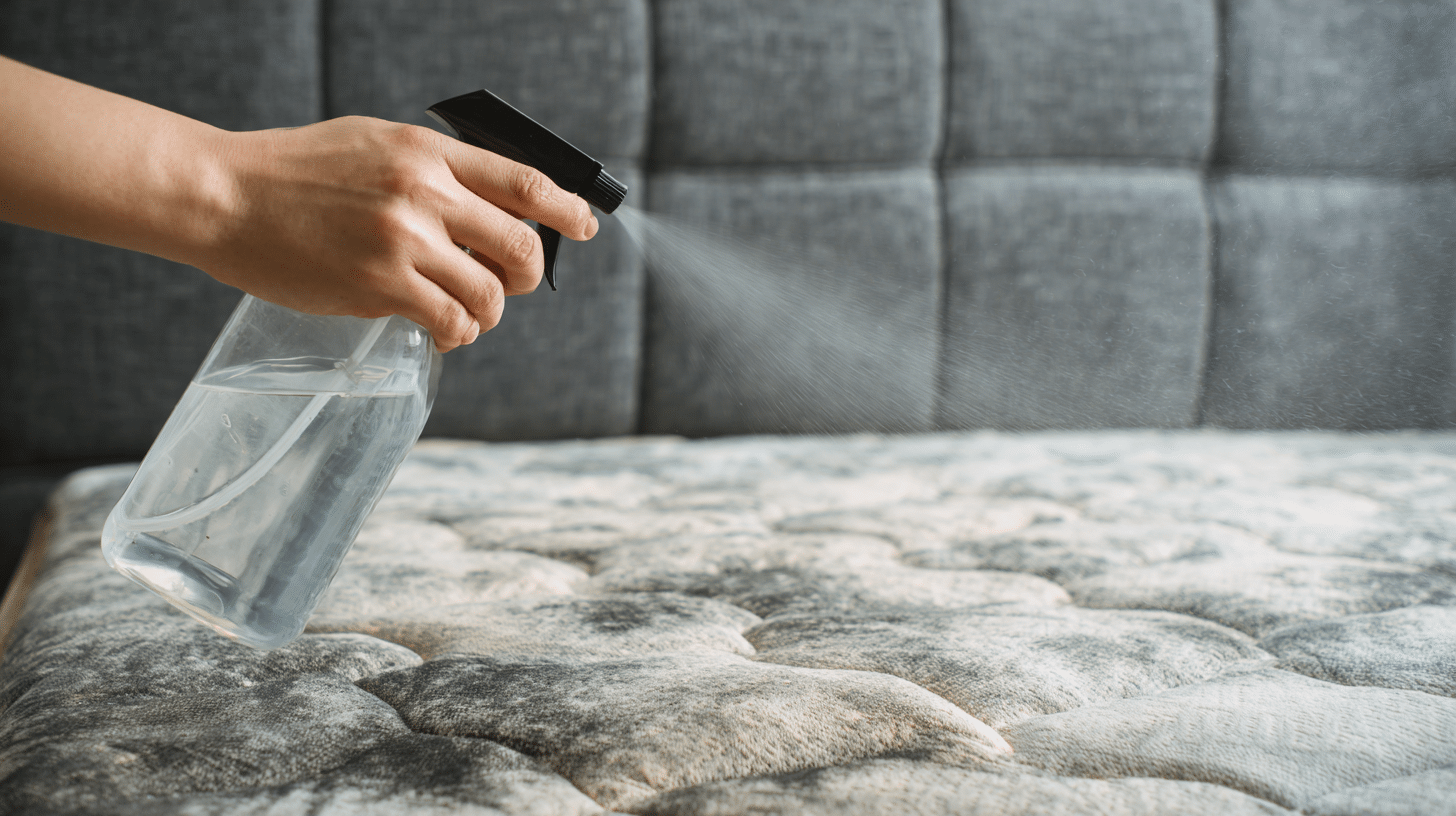
Finding mold on your mattress doesn’t automatically mean you need to throw it away and purchase a replacement.
Several effective cleaning methods can eliminate mold and restore your mattress to a safe, healthy condition when applied correctly and promptly.
Method 1: White Vinegar Spray Method
White vinegar’s natural acidity creates an environment hostile to mold growth while effectively killing most common mold species.
This method also neutralizes musty odors that accompany mold contamination, providing both cleaning and deodorizing benefits.
|
Steps:
|
Method 2:Baking Soda and Sunlight Treatment
The combination of baking soda’s moisture-absorbing properties and sunlight’s natural UV sterilization creates a powerful mold-fighting duo.
UV rays naturally kill mold spores while baking soda draws out trapped moisture that enables fungal growth.
|
Steps:
|
Method 3:Rubbing Alcohol Solution
Rubbing alcohol’s antimicrobial properties effectively disinfect contaminated areas while preventing mold spores from spreading to clean sections.
The alcohol evaporates quickly, reducing moisture that could encourage further mold development during the cleaning process.
|
Steps:
|
Method 4: Hydrogen Peroxide Treatment
Hydrogen peroxide penetrates fabric fibers deeply to reach mold spores at their source while breaking down organic matter.
The bubbling action helps lift dead mold particles from the mattress surface, making removal more thorough than surface-only treatments.
|
Steps:
|
Remember that severe mold infestations may require professional cleaning services or complete mattress replacement for health and safety reasons.
When to Replace Your Mattress
Sometimes cleaning isn’t enough to address serious mold contamination that has penetrated deep into mattress materials.
Replacement becomes necessary when mold covers large areas, penetrates completely through layers, or returns repeatedly after cleaning attempts.
If cleaning attempts don’t eliminate the smell or visible mold completely after multiple treatments, it’s time to invest in a new mattress.
Professional assessment can help determine whether cleaning or replacement represents the better option for your specific situation.
Tips to Prevent Mold from Growing on a Mattress
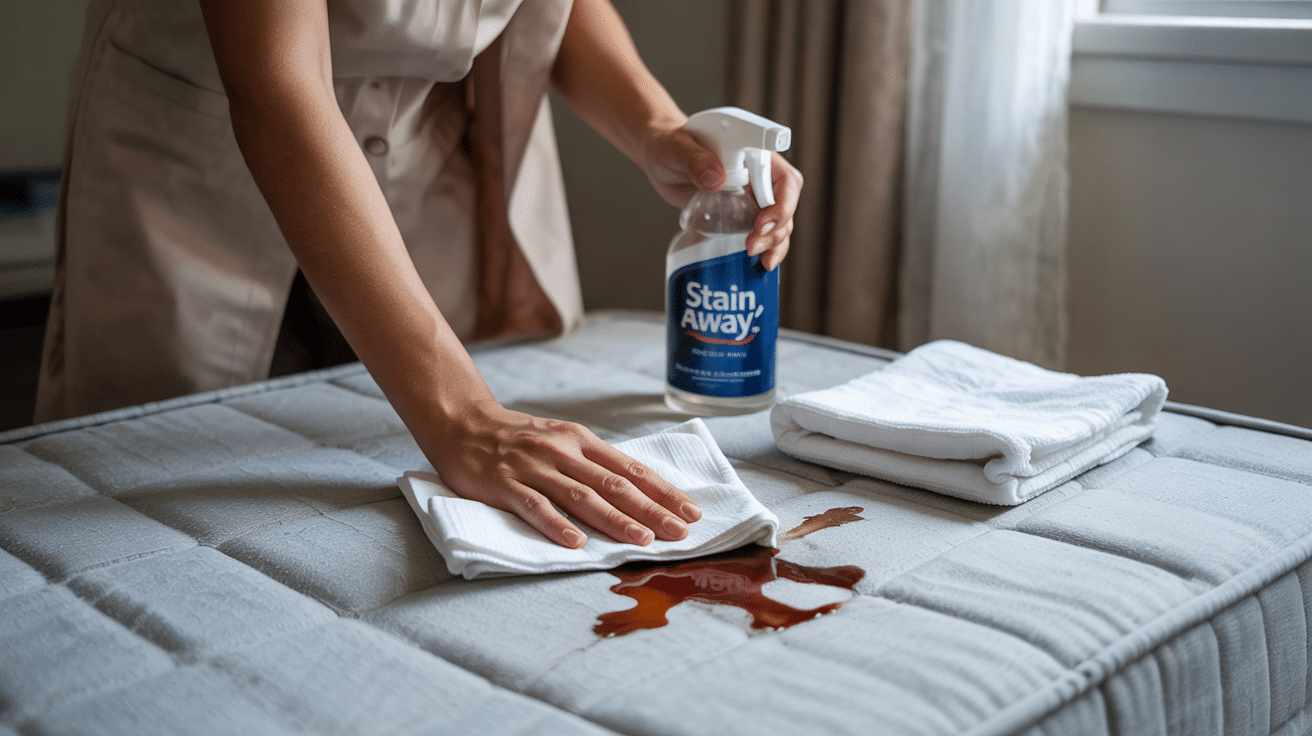
Preventing mattress mold is much easier and cheaper than dealing with it after it takes hold. Simple daily habits and smart bedroom choices can keep your sleep space healthy and mold-free.
- Use a waterproof mattress protector: It blocks moisture from spills, sweat, or accidents from seeping into the mattress.
- Let your bed breathe: Raising the bed allows airflow underneath to reduce trapped humidity.
- Keep the bedroom dry and well-ventilated: Proper ventilation prevents moisture buildup that encourages mold growth.
- Clean spills and sweat promptly: Immediate cleanup stops moisture from settling deep into the mattress.
- Rotate and sun your mattress occasionally: Sunlight naturally kills mold spores and helps dry out hidden moisture.
Conclusion
Finding mold on your mattress can feel overwhelming, but you now have the knowledge to tackle this problem head-on.
Prevention is always easier than cleanup. Controlling humidity, ensuring proper ventilation, and addressing spills quickly saves you from bigger headaches.
If you opt for DIY cleaning methods or decide it’s time for a new mattress, acting promptly safeguards your health and wallet. Don’t overlook the warning signs.
Have you spotted any of these mold warning signs on your own mattress? Share your experience in the comments below and let others know what worked for your situation.
Frequently Asked Questions
Can Mold on A Mattress Make You Sick?
Yes, mold exposure can trigger allergies, asthma, and other respiratory issues, especially during sleep. It’s important to remove it promptly to protect your health.
Is It Safe to Sleep on A Mattress with Mold?
No, sleeping on a moldy mattress can expose you to harmful spores and irritants. It’s best to clean or replace the mattress immediately.
What Does Mold on A Mattress Look Like?
Mold often appears as black, green, or bluish spots with a fuzzy or slimy texture. It may also be accompanied by a strong musty odor.

